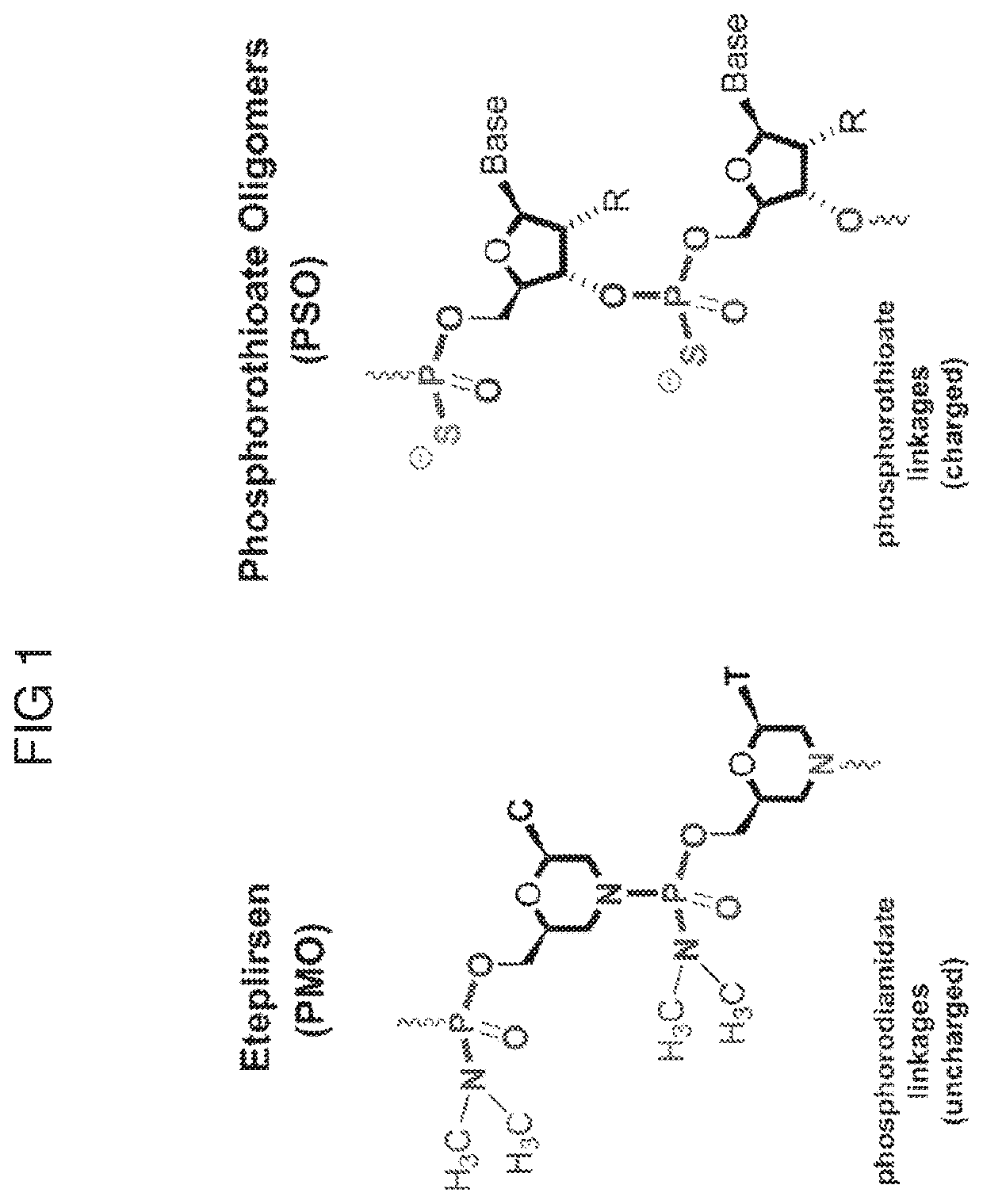Combination therapies for treating muscular dystrophy
- Summary
- Abstract
- Description
- Claims
- Application Information
AI Technical Summary
Benefits of technology
Problems solved by technology
Method used
Image
Examples
example 1
CAT-1004 in Combination with M23D PMO Reduces Inflammation and Fibrosis in Mdx Mice
[0450]To assess the effectiveness of a combination treatment of an exon skipping antisense oligonucleotide and an NF-Kb inhibitor in Duchenne muscular dystrophy, M23D PMO and CAT-1004 were utilized in the Mdx mouse model. The effect on inflammation and fibrosis was determined by analyzing samples of muscle taken from the quadriceps, of (1) wild-type mice treated with saline, (2) mdx mice treated with saline, (3) mdx mice treated with CAT-1004, (4) mdx mice treated with the M23D PMO, and (5) mdx mice treated with the M23D PMO in combination with CAT-1004. The tissue sections were analyzed for fibrosis by picrosirius red staining and for inflammation and fibrosis by Hematoxylin and Eosin (H&E) staining, as described in the Materials and Methods section above.
[0451]Treatment of Mdx mice with either M23D PMO or CAT-1004 as monotherapies resulted in a reduction of inflammation and fibrosis as compared to M...
example 2
Exon Skipping and Dystrophin Production in Mdx Mice Treated with the M23D PMO and the M23D PMO in Combination with CAT-1004
[0452]To analyze the extent of exon skipping and dystrophin production in mice treated with the M23D PMO in combination with CAT-1004, samples of muscle were taken from the quadriceps, diaphragm, and heart of (1) wild-type mice treated with saline, (2) mdx mice treated with saline, (3) mdx mice treated with CAT-1004, (4) mdx mice treated with the M23D PMO, and (5) mdx mice treated with the M23D PMO in combination with CAT-1004. RT-PCR analysis for exon 23 skipping was performed as well as Western blot analysis to determine dystrophin protein levels.
[0453]Exon skipping was observed in the muscle of the quadriceps, diaphragm, and heart of the Mdx mice treated with the M23D PMO as well as mice treated with the M23D PMO in combination with CAT-1004 (FIG. 10). Surprisingly, enhanced dystrophin production was observed in the muscle of the quadriceps, diaphragm, and he...
example 3
Immunohistochemical Analysis of Dystrophin Expression in the Quadriceps
[0454]To further analyze dystrophin expression, immunohistochemical analysis was performed in sections of muscle taken from the quadriceps of (1) wild-type mice treated with saline, (2) mdx mice treated with saline, (3) mdx mice treated with CAT-1004, (4) mdx mice treated with the M23D PMO, and (5) mdx mice treated with the M23D PMO in combination with CAT-1004.
[0455]Tissue sections were stained with both dystrophin and laminin. The results are shown in FIG. 12. An increase in dystrophin expression was observed in Mdx mice treated with the M23D PMO monotherapy as well as the M23D PMO in combination with CAT-1004 as compared to Mdx control mice treated with saline or Mdx mice treated with CAT-1004 monotherapy. These results indicated that combination treatment further enhanced sarcolemmal dystrophin
[0456]All publications and patent applications cited in this specification are herein incorporated by reference as if...
PUM
| Property | Measurement | Unit |
|---|---|---|
| Time | aaaaa | aaaaa |
| Dimensionless property | aaaaa | aaaaa |
| Frequency | aaaaa | aaaaa |
Abstract
Description
Claims
Application Information
 Login to View More
Login to View More - Generate Ideas
- Intellectual Property
- Life Sciences
- Materials
- Tech Scout
- Unparalleled Data Quality
- Higher Quality Content
- 60% Fewer Hallucinations
Browse by: Latest US Patents, China's latest patents, Technical Efficacy Thesaurus, Application Domain, Technology Topic, Popular Technical Reports.
© 2025 PatSnap. All rights reserved.Legal|Privacy policy|Modern Slavery Act Transparency Statement|Sitemap|About US| Contact US: help@patsnap.com



